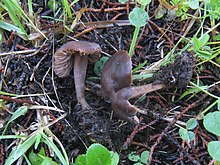
Hygrocybe is a genus of agarics in the family Hygrophoraceae. Called waxcaps in English, basidiocarps are often brightly coloured and have waxy to slimy caps, white spores, and smooth, ringless stems. In Europe they are characteristic of old, unimproved grasslands which are a declining habitat, making many Hygrocybe species of conservation concern. Elsewhere they are more typically found in woodlands. Most are ground-dwelling and all are believed to be moss associates. Around 150 species are recognized worldwide. Fruit bodies of several Hygrocybe species are considered edible and are sometimes offered for sale in local markets.

Hygrocybe punicea is a species of agaric in the family Hygrophoraceae. It has been given the recommended English name of Crimson Waxcap. The species has a European distribution, occurring mainly in agriculturally unimproved grassland. Threats to its habitat have resulted in the species being assessed as globally "vulnerable" on the IUCN Red List of Threatened Species. Records of H. punicea from North America, East Asia, and Australia require further research to see if they represent the same species.

Cuphophyllus is a genus of agaric fungi in the family Hygrophoraceae. Cuphophyllus species belong to a group known as waxcaps in English, sometimes also waxy caps in North America or waxgills in New Zealand. The genus was described by French mycologist Marcel Bon in 1985. It is synonymized with Hygrocybe by some authorities, although recent molecular evidence confirms its validity as a distinct genus.

Porpolomopsis lewelliniae, commonly known as the mauve splitting wax-cap, is a gilled fungus of the waxcap family found in wet forests of eastern Australia and New Zealand. The small mauve- or lilac-coloured mushrooms are fairly common and appear in moss or leaf litter on the forest floor in autumn, and are biotrophic. The key distinguishing feature is the splitting of the cap dividing down the middle of the individual gills.
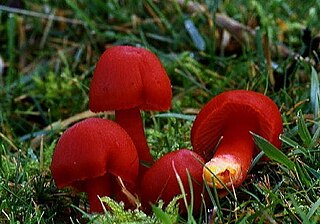
Hygrocybe coccinea, sometimes called the scarlet hood, scarlet waxcap or righteous red waxy cap, is a colourful member of the mushroom genusHygrocybe. These waxcaps are found across the Northern Hemisphere from China and Japan to Europe and North America. The small bright red mushroom is a familiar sight in unimproved grasslands in Europe in late summer and autumn, and woodlands in North America in winter.

Waxcap grassland is short-sward, nutrient-poor grassland that supports a rich assemblage of larger fungi, particularly waxcaps, characteristic of such habitats. Waxcap grasslands occur principally in Europe, where they are declining as a result of agricultural practices. The fungal species are consequently of conservation concern and efforts have been made in the United Kingdom and elsewhere to protect both the grasslands and their characteristic fungi.

Porpolomopsis calyptriformis is a species of agaric in the family Hygrophoraceae. It has been given the recommended English name of Pink Waxcap. The species has a European distribution, occurring mainly in agriculturally unimproved grassland. Threats to its habitat have resulted in the species being assessed as globally "vulnerable" on the IUCN Red List of Threatened Species. A similar but as yet unnamed species occurs in North America.

Hygrocybe chlorophana is a species of agaric in the family Hygrophoraceae. It has been given the recommended English name of golden waxcap in the UK. The species has a largely north temperate distribution, occurring in grassland in Europe and in woodland in North America and northern Asia; it has also been reported from mountainous areas of southern Australia. It typically produces basidiocarps in the autumn. In a few European countries, H. chlorophana is of conservation concern, appearing on national red lists of threatened fungi.
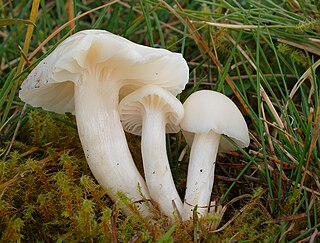
Cuphophyllus virgineus is a species of agaric in the family Hygrophoraceae. Its recommended English common name is snowy waxcap in the UK. The species has a largely north temperate distribution, occurring in grassland in Europe and in woodland in North America and northern Asia, but is also known from Australia. It typically produces basidiocarps in the autumn.

Cuphophyllus pratensis is a species of agaric in the family Hygrophoraceae. It has been given the recommended English name of meadow waxcap in the UK and in North America has variously been called the meadow waxy cap, salmon waxy cap, and butter meadowcap. The species has a widespread, mainly temperate distribution, occurring in grassland in Europe and in woodland elsewhere. The basidiocarps are edible and are occasionally collected and sold commercially.

Gliophorus irrigatus is a species of agaric in the family Hygrophoraceae. It has been given the recommended English name of slimy waxcap in the UK. The species is widespread in temperate regions, occurring in grassland in Europe and in woodland in North America and elsewhere.

Hygrocybe quieta is a species of agaric in the family Hygrophoraceae. It has been given the recommended English name of oily waxcap in the UK. The species has a European distribution and typically occurs in grassland where it produces basidiocarps in the autumn. In several countries, H. quieta is of conservation concern, appearing on national red lists of threatened fungi.

Hygrocybe splendidissima, is a species of agaric in the family Hygrophoraceae. It has been given the recommended English name of Splendid Waxcap. The species has a European distribution, occurring mainly in agriculturally unimproved grassland. Threats to its habitat have resulted in the species being assessed as globally "vulnerable" on the IUCN Red List of Threatened Species.
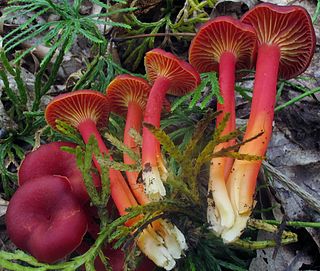
Hygrocybe appalachianensis, commonly known as the Appalachian waxy cap, is a gilled fungus of the waxcap family. It is found in the eastern United States, where it fruits singly, in groups, or clusters on the ground in deciduous and mixed forests. The species, described in 1963 from collections made in the Appalachian Mountains, was originally classified in the related genus Hygrophorus. It was transferred to Hygrocybe in 1998, in which it has been proposed as the type species of section Pseudofirmae.

Hygrocybe citrinovirens is a species of agaric in the family Hygrophoraceae. It has been given the recommended English name of Citrine Waxcap. The species has a European distribution, occurring mainly in agriculturally unimproved grassland. Threats to its habitat have resulted in the species being assessed as globally "vulnerable" on the IUCN Red List of Threatened Species.

Hygrocybe aurantiosplendens, commonly known as the orange waxcap, is a gilled fungus in the family Hygrophoraceae. It mainly occurs in Europe, but is also found in Siberia, and on both the East and West coasts of North America. It is uncertain if the continental ecotypes are in fact conspecific and are sometimes treated as distinct species.
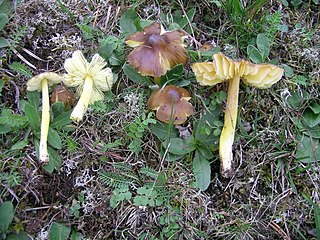
Hygrocybe spadicea is a species of agaric in the family Hygrophoraceae. It has been given the recommended English name of Date Waxcap. The species has a European distribution, occurring mainly in agriculturally unimproved grassland. Threats to its habitat have resulted in the species being assessed as globally "vulnerable" on the IUCN Red List of Threatened Species.
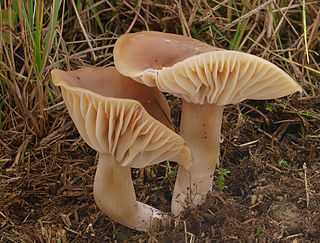
Cuphophyllus colemannianus is a species of agaric in the family Hygrophoraceae. It has been given the recommended English name of Toasted Waxcap. The species has a European distribution, occurring mainly in agriculturally unimproved grassland. Threats to its habitat have resulted in the species being assessed as globally "vulnerable" on the IUCN Red List of Threatened Species.

Cuphophyllus lacmus is a species of agaric in the family Hygrophoraceae. It has been given the recommended English name of Grey Waxcap. The species has a European distribution, occurring mainly in agriculturally unimproved grassland. Threats to its habitat have resulted in the species being assessed as globally "vulnerable" on the IUCN Red List of Threatened Species.
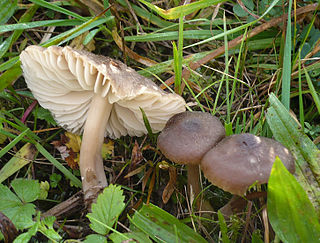
Neohygrocybe nitrata is a species of agaric in the family Hygrophoraceae. It has been given the recommended English name of Nitrous Waxcap, based on its smell. The species has a European distribution, occurring mainly in agriculturally unimproved grassland. Threats to its habitat have resulted in the species being assessed as globally "vulnerable" on the IUCN Red List of Threatened Species.
